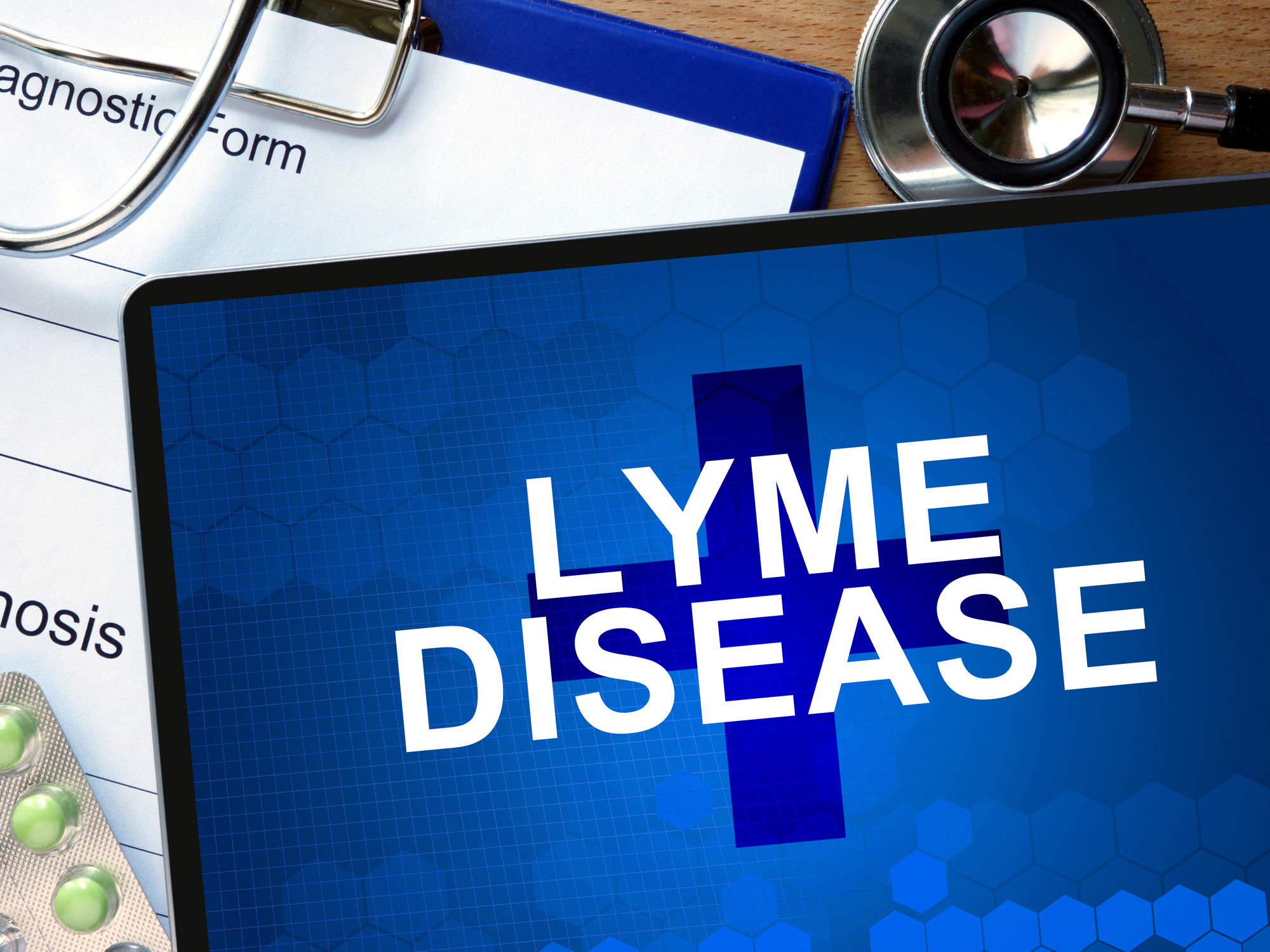Get Easy Health Digest™ in your inbox and don’t miss a thing when you subscribe today. Plus, get the free bonus report, Mother Nature’s Tips, Tricks and Remedies for Cholesterol, Blood Pressure & Blood Sugar as my way of saying welcome to the community!
Protect yourself from the growing threat of Lyme disease

There’s a silent epidemic creeping up around us, and mainstream medicine has only just begun to take a serious look…
I’m talking about Lyme disease.
Conventional treatment for this devastating illness is first-line antibiotic therapy after infection occurs. The problem with that is… most people who contract Lyme disease don’t know they’ve been exposed until years later when symptoms begin to surface: aches and flu-like feelings, severe pain and stiffness, rashes, fatigue, neurological problems, blood pressure spikes and more. By then antibiotics are practically useless.
Once the infection takes hold, the bacteria that causes Lyme hides within cells and tissues where antibiotics — pharmaceutical or natural — often can’t reach. Natural treatment is difficult, and requires a strategic protocol that takes into account contributing co-factors, including genetic susceptibility, which can make the condition more difficult to treat.
Fastest growing vector-borne disease
A vector-borne illness is one that’s caused by a microorganism transmitted by an insect bite such as a tick or mosquito. In this case, the microorganism that causes Lyme disease is a spiral shaped bacteria called Borelia burgdorferi, and it’s transmitted by infected deer ticks, the tiny black ones that are often smaller than a flea.
These ticks live primarily on deer and other wildlife, and with wild animal population booms over the last decade, we’re seeing a corresponding increase in Lyme disease in people, as our environments increasingly overlap. Importantly, while the tiny deer tick appears to be the primary carrier of Lyme disease, other reports suggest that any tick can be a carrier of Lyme, such as various species of dog ticks.
Obviously, we have innate aversions to ticks for a reason — so if you get a bite from any type of tick, take a deep breath and don’t rush the removal process. For proper tick removal, follow these instructions from the CDC. Many county health departments will test your tick for the Lyme bacteria. However, even if the tick tests negative, they are often carriers of other organisms that can cause co-infections, so taking antibiotics immediately following a tick bite is still a good idea. Check with your integrative health care practitioner for recommended treatment protocols for post-bite prophylaxis.
Hard numbers
It’s estimated that Lyme disease strikes between 20,000 and 30,000 people each year, mostly in the northeast and northwest United States — though with the rise in numbers, cases have been documented throughout the US. Delayed diagnosis and treatment can lead to a chronic, degenerative and highly debilitating condition that persists for years. And many cases are misdiagnosed initially.
Equally concerning, researchers are now beginning to believe that the disease is sexually transmittable and that partners can infect each other unknowingly. Updated recommendations for preventing the spread of Lyme disease, which include this new information, have not yet made it into the mainstream literature and may take years to do so until the evidence is proven more definitely. So with these new potential risks identified, it’s best to play safe.
Lyme disease in its early stages is most often recognizable by a telltale “bull’s-eye” rash at the site of the tick bite, which can appear an average of 1 to 2 weeks (range = 3 to 30 days) after disease transmission. Unfortunately, the rash can sometimes be concealed, on top of the head for example, or in many cases, it may not appear at all. In these instances, diagnosis is often delayed or missed completely until the infection becomes chronic.
More than just a tick bite
Lyme disease is a stealthy intruder, but it doesn’t always act alone. While the bacterium triggers the initial flu-like symptoms, other chronic health conditions can make this degenerative disease much worse — and more difficult to treat. Compounding co-factors include: chronic inflammation, immune suppression, co-infections from viruses, parasites, other bacteria, and fungi; and elevated levels of heavy metals and toxins. These factors can create a complex pathology of Lyme disease — in other words, we’re dealing with more than just B. burgdorferi. While antibiotics are a front-line approach if caught early on, alone they’re not enough. Successful treatment requires multi-layered solutions involving some of the following strategies.
The role of toxic metals
Lead, mercury, cadmium and other toxic metals fuel inflammation and suppress immune function. Environmental toxins and mold/fungi are also a threat. Furthermore, Lyme disease promotes chronic inflammation and hinders the body’s detoxification systems. Elevated toxic body burden, systemic inflammation and reduced immunity create a vicious cycle of vulnerability, allowing Lyme and other infections a stronger foothold.
To halt this destructive cycle, detoxification therapies, anti-inflammatory approaches and the diagnosis and treatment of co-infections (including other tick-borne microbes such as Babesia) need to be incorporated into an integrative, holistic treatment protocol.
Keys to detox
Published clinical studies demonstrate that the supplement Modified Citrus Pectin (MCP), a highly bio-available form of pectin, safely removes toxic metals such as lead, mercury and arsenic from the body without disrupting essential minerals. MCP also targets systemic inflammation by blocking a pro-inflammatory protein called galectin-3. Other research demonstrates that MCP activates immune cells and increases their functionality in both the innate and adaptive immune response. Alginates, derived from brown seaweed, also have detoxifying, immune enhancing and anti-inflammatory properties.
Lyme disease susceptibility genes
The real importance of detoxification in patients with Lyme disease can be seen in genetic tests. Lyme patients often demonstrate a genetic predisposition, diagnosed with specific HLA DR genetic testing. Patients with certain genes such as HLA DRB1 15, DQ 6 and/or other HLA genes are highly sensitive to neuro-toxins such as mold and fungus, byproducts of Babesia and other infections, toxic metals, pesticides, industrial chemicals and more. For such patients, antibiotics don’t work as well either. These genetic predispositions prevent people with Lyme disease from being able to eliminate the neuro-toxins produced by the bacterium and other possible co-infections. In this case, MCP and alginates can help significantly by binding to these toxins and helping eliminate them. In my clinical practice, I use these and other targeted detoxification agents to help safely reduce toxic body burden and inflammation in my patients, support a more thorough treatment of Lyme disease over the long term and enhance the effectiveness of other treatments.
Hiding out
Lyme bacterium, co-infections and their toxic by-products hide within the nervous system, including the brain, creating a special challenge to treat. So compounds that penetrate the blood-brain barrier are critical. Artemisinin, an active ingredient from Artemisia Annua (wormwood) and its derivative Artesunate, can achieve this.
Another place where Lyme bacterium may hide in the body is within biofilms. Biofilms are protective coatings formed by microorganism colonies like candida and Borelia. Though it’s a relatively new field of research, a growing body of data suggests that Lyme bacterium build protective biofilm matrixes in the digestive tract and elsewhere in the body, to shield themselves from treatments as well as immune surveillance. The multi-targeted strategy of breaking up biofilms with specific enzymes, fighting the infections with antimicrobial agents, and following with detoxification and probiotic treatment, is proving to be a potential solution to numerous persistent infections.
In truth, there are many integrative strategies to help strengthen immunity, detoxify the system, fight infections and reduce inflammation. Phosphatidylcholine helps remove toxins from the nervous system, while glutathione flushes them from the body, cools inflammation and boosts immunity. Other complementary treatments such as acupuncture, full body heat treatments, and other naturopathic IV therapies help reduce inflammation, target infections, support neurological health, increase vital energy and restore balance to the system.
If you have concerns about Lyme disease, it’s critical to work with an integrative health provider experienced in this area of treatment. Lyme disease is a complicated condition, but that doesn’t mean you are powerless against it. By integrating conventional treatments like antibiotics (especially in the early stages), with naturopathic approaches to boost immunity, fight infection, remove toxins, target biofilms and fight inflammation, we can control this debilitating condition, address potential complications and restore health and vitality over time.
On November 17th, I will be offering a free, educational webinar on innovative approaches to Lyme disease, highlighting a number of these integrative strategies. To register, click here.












